Introduction
Sous vide cooking has taken the culinary world by storm and for good reason. It guarantees perfectly cooked proteins every time, without stress or guesswork. And when it comes to chicken breast, the most commonly overcooked cut, sous vide is a game-changer. But what if you’re starting with a frozen chicken breast straight from the freezer?
The question “Can you sous vide frozen chicken breast?” is trending right now, and the answer is a resounding yes. In fact, sous vide frozen chicken breast is not only possible it’s practical, delicious, and safer than you might think..Cooked 3 oz Chicken Breast
This method offers busy home cooks and meal preppers a reliable way to turn solid frozen chicken into juicy, flavorful, tender meat without ever thawing. The sous vide technique uses precise temperature control to cook proteins evenly from edge to center. Whether you’re new to sous vide or already a fan, this guide breaks down everything you need to know: the why, the how, and the wow.
In this comprehensive article, you’ll learn:
- Why cooking chicken breast from frozen using sous vide works so well.
- A detailed step-by-step method for getting juicy, flavorful results.
- Flavor tips, temperature guides, and searing secrets.
- Pro safety tips and common FAQs.
- And reliable references including Serious Eats sous vide chicken breast instructions and maple citrus glazed sous vide chicken method.
Let’s dive into the science, simplicity, and flavor-packed potential of sous vide frozen chicken breast. By the end, you’ll know how to master this technique with confidence and maybe even ditch thawing altogether.
Benefits of Cooking Frozen Chicken Breast Sous Vide
Cooking frozen chicken breast sous vide offers a range of benefits, especially when compared to conventional methods like oven baking or pan frying. This method is not just about convenience it’s about delivering consistent, flavorful, and safe results that rival restaurant-quality meals.
Safety and Foodborne Pathogen Control
One of the top concerns when cooking chicken frozen or not is food safety. Poultry can harbor harmful bacteria like Salmonella and Campylobacter, and undercooking it can pose serious health risks. This is where sous vide shines.
With sous vide, you can safely cook frozen chicken breast by ensuring the meat reaches and holds an exact internal temperature over a longer period of time. For example, cooking at 140°F (60°C) for 1.5 to 2 hours will pasteurize the meat while keeping it incredibly moist.
Unlike microwaving or pan-frying from frozen (which often cooks unevenly), sous vide applies precise, gentle heat uniformly. That means the core of the frozen meat heats gradually, preventing dangerous cold spots. According to FoodSafety.gov, maintaining chicken at a minimum of 165°F for just a few seconds or slightly lower for longer durations kills harmful pathogens effectively.
This technique removes the guesswork from safe cooking. It also avoids overcooking the outer layers while waiting for the center to thaw and reach the correct internal temperature.
Texture and Juiciness from Frozen to Perfect
When chicken is cooked traditionally from frozen, it’s almost impossible to hit the ideal doneness. The outside often gets tough or rubbery before the inside is cooked through. Sous vide changes that dynamic.
Sous vide cooking locks in moisture and keeps fibers intact. Because the temperature never exceeds your set point (e.g., 140°F or 150°F), there’s no risk of overcooking. The water bath gently brings the entire chicken breast frozen or fresh to a uniform texture..Piccata Sauce
What you get is tender, juicy, perfectly cooked chicken breast every time. The transformation is remarkable: no stringy dryness, no chewy edges, and no bland bite. This technique retains natural juices and even enhances flavor absorption, especially when you season or marinate before freezing.
Time-Saving and Convenient Meal Prep
Let’s be honest how many times have you forgotten to thaw the chicken? That frustrating dinner dilemma is no longer an issue with sous vide.
The beauty of this method is that you can cook frozen chicken breasts directly from the freezer without any planning ahead. That makes it ideal for:
- Weeknight meals
- Healthy meal prep for the week
- Bulk cooking for fitness or family needs
You can vacuum seal seasoned chicken breasts and freeze them ahead of time. When you’re ready, just drop a sealed frozen breast into the sous vide bath. While it takes a bit longer than cooking thawed meat, it’s entirely hands-off and worry-free.
Plus, there’s less cleanup. No pans, no mess just a pot of water and a protein pouch. This makes sous vide one of the most convenient and stress-free ways to cook frozen chicken breasts with gourmet results.
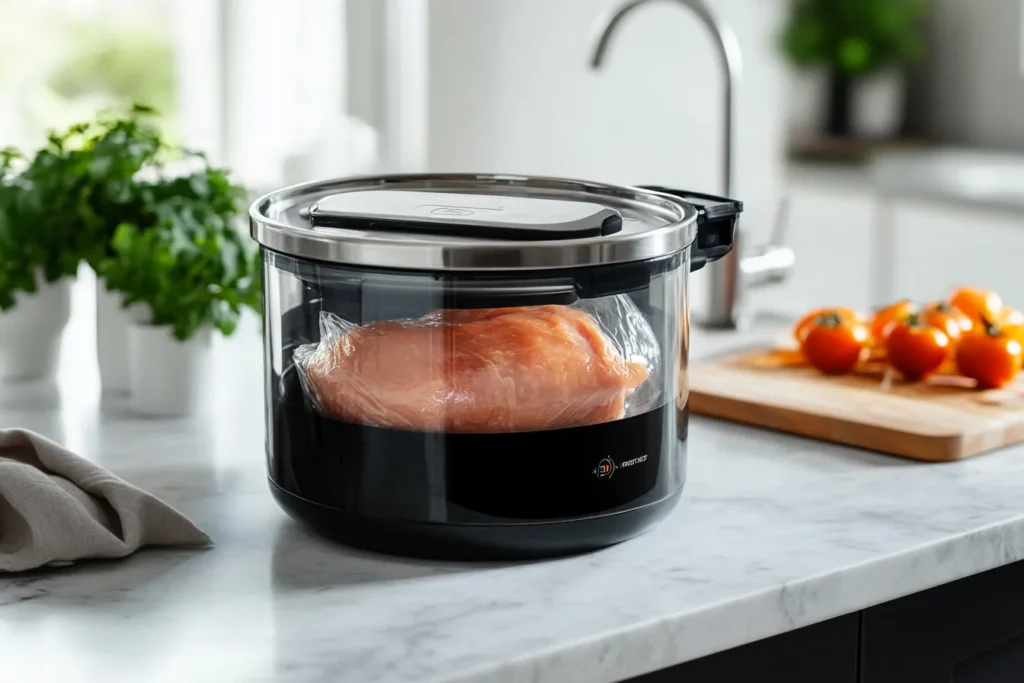
How to Sous Vide Frozen Chicken Breast: Step‑by‑Step
Now that we’ve covered the advantages, let’s break down exactly how to cook frozen chicken breast using sous vide. Whether you’re a seasoned home cook or just starting with sous vide, this step-by-step process ensures perfect results every time.
Equipment You Need
Before getting started, make sure you have the following tools:
- Sous Vide Precision Cooker (Immersion Circulator)
This is the heart of the process. Brands like Anova, Breville Joule, and Inkbird are popular options. These devices maintain your water at a precise temperature for even cooking. - Large Pot or Heat‑Safe Container
You’ll need something to hold the water bath. For efficiency and insulation, some people use a polycarbonate container with a lid. - Vacuum Sealer or Freezer‑Safe Zip Bag
Vacuum sealing is ideal for even heat distribution and quick freezing. However, high‑quality zip bags (like Ziploc freezer bags) can work using the water displacement method. - Tongs or Slotted Spoon
To remove the chicken safely from the hot bath. - Thermometer (optional but helpful)
Especially if you want to double-check internal temperatures or searing heat later.
Preparing the Chicken: Seasoning and Bagging While Frozen
One of the best sous vide meal prep tips is seasoning before freezing. This locks in flavor and saves time later.
- Season the Chicken Before Freezing
Lightly season your chicken breast with salt, pepper, garlic powder, or your favorite spice blend. You can also add a sprig of rosemary, thyme, lemon zest, or a touch of olive oil or butter for extra flavor. - Vacuum Seal or Use Water Displacement Method
Place each chicken breast into its own vacuum-sealed bag or Ziploc freezer bag. Remove as much air as possible. If you’re freezing in bulk, separate breasts with parchment to avoid sticking. - Freeze Flat
Lay bags flat in the freezer for even freezing and easier water circulation when cooking.
💡 Pro tip: Try marinating in maple-citrus glaze or herbed garlic butter before freezing. This method adds rich flavor and works beautifully with sous vide.
Temperature and Time Guide for Frozen Chicken Breast
The main difference when cooking frozen vs fresh is adding extra time to allow for thawing inside the water bath. Here’s a reliable temperature and timing guide:
| Temp (°F) | Temp (°C) | Texture | Cook Time (from Frozen) |
|---|---|---|---|
| 140°F | 60°C | Very tender, juicy | 1.5 – 2.25 hours |
| 145°F | 62.7°C | Juicy, slightly firmer | 1.5 – 2 hours |
| 150°F | 65.6°C | Firm and sliceable | 1.5 – 2 hours |
| 160°F | 71.1°C | Traditional cooked feel | 1.5 – 2 hours |
If cooking fresh/thawed chicken, subtract about 30 minutes from the total time.
60 °C / 140 °F for 1.5–2 hours – very tender
This is a favorite setting among sous vide enthusiasts for juicy, slightly pink-in-the-center chicken. Don’t worry—it’s completely pasteurized and safe after 1.5 hours at this temp.
Higher temps (65 °C–67 °C) for classic firmness
If you prefer a more traditional cooked texture, go higher. Chicken at 150–160°F (65.6–71.1°C) still turns out moist but has less bounce and more firmness, like oven-roasted meat.
📝 Reminder: Always ensure chicken is fully submerged in the water bath. Use sous vide weights or clips if needed to keep bags underwater.
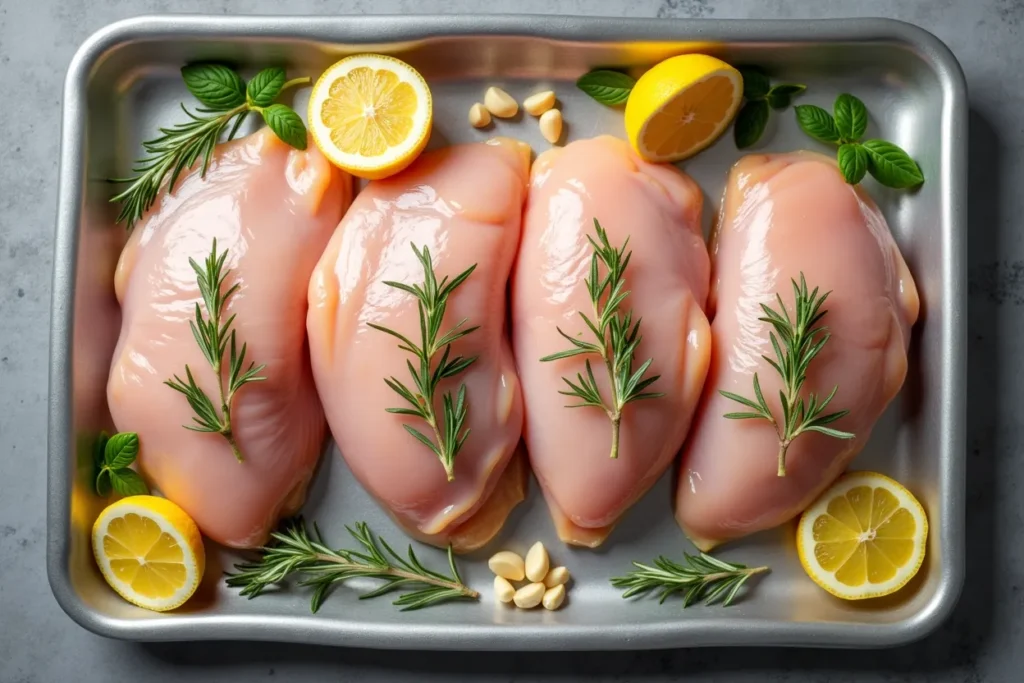
Flavor Enhancements and Marinade Techniques
One of the best things about sous vide cooking is how it enhances flavor especially when you’re working with frozen chicken breast. Even from a frozen state, seasonings and marinades can penetrate the meat thanks to the long cooking time and low, controlled temperatures. You’re not just cooking efficiently; you’re infusing every bite with incredible taste.
Using Citrus, Herbs, Garlic, Butter or Maple Glaze
While basic salt and pepper do the job, adding bold flavors will elevate your dish to another level. Here are a few sous vide-friendly combinations that work exceptionally well with frozen chicken breasts:
- Citrus & Herb Marinade
Before freezing, add slices of lemon or orange, fresh thyme, rosemary, and a drizzle of olive oil. The citrus breaks down connective tissue slightly and imparts brightness. - Garlic Butter & Paprika Blend
Toss in a tablespoon of unsalted butter, a pinch of smoked paprika, and crushed garlic cloves. As the chicken bathes in the sous vide, the butter melts and envelops it with richness. - Maple Glaze with Dijon and Soy Sauce
This combination adds both sweetness and umami. Mix maple syrup, a teaspoon of Dijon mustard, and low-sodium soy sauce, then coat your chicken before vacuum sealing.
For full inspiration, check out the maple citrus glazed sous vide chicken method from Two Kooks in the Kitchen it’s perfect for frozen prep.
Tips:
- Don’t overdo strong acids (like too much vinegar or lemon juice) when prepping to freeze they may alter texture over time.
- If you freeze with marinades, be sure they’re evenly distributed in the bag to coat the entire surface of the chicken.
Once the sous vide process is complete, many of these flavor bases concentrate into a rich, silky juice that can double as a sauce.
Inspired by External Recipes (link to Serious Eats article)
If you’re looking for even more gourmet variations, Serious Eats’ sous vide chicken breast recipe is a top-tier resource. They break down how flavor interacts with proteins and why sous vide enhances even simple seasonings.
Their recommendations include:
- Simple Salt and Butter: Classic and clean, especially when paired with searing.
- Spiced Dry Rubs: Apply before freezing; the long cook time will deepen the flavor.
- Post-Cook Sauces: From chimichurri to miso glaze, finishing sauces take the chicken to restaurant-quality levels.
Because sous vide doesn’t rely on high heat or browning during the cook itself, it’s essential to think about seasoning and flavor layering before sealing. You get back what you put in often with richer, more aromatic results than with traditional cooking.
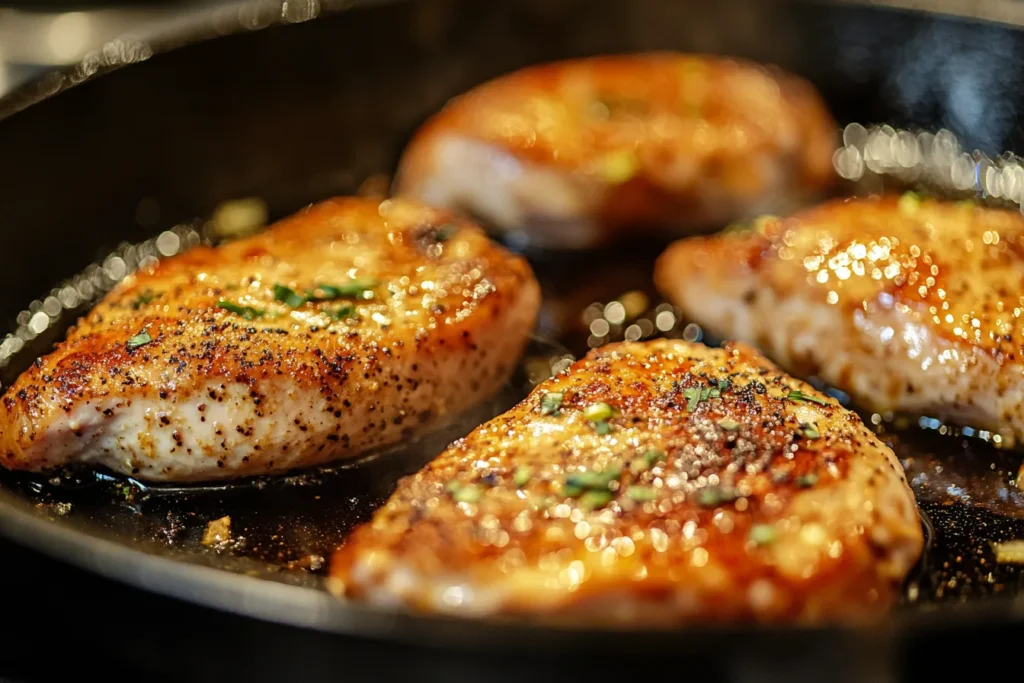
Finishing the Chicken: Searing, Grilling, or Broiling
Once your frozen chicken breast has been gently cooked to perfection in the sous vide bath, it’s time for the finishing touch. While sous vide locks in moisture and tenderness, it doesn’t brown the meat. That means you need a final sear or grill to develop flavor, texture, and visual appeal.
This last step only takes a few minutes, but it transforms your chicken from soft and pale to golden and delicious.
Achieving a Golden Crust
The Maillard reaction the chemical reaction responsible for browning meat requires high, dry heat. Your sous vide chicken is already cooked internally, so the goal is to develop a crispy crust without overcooking the juicy interior.
Here’s how to do it:
1. Dry the Chicken Completely
As soon as you remove the chicken from its vacuum-sealed bag, pat it very dry with paper towels. Moisture on the surface prevents browning and causes splattering.
2. Use a Hot Pan with High-Smoke Point Oil
Cast iron or stainless-steel pans are best. Preheat over medium-high heat and use oils like avocado oil or grapeseed oil—they can handle the heat without burning.
3. Sear Quickly – 30 to 60 Seconds per Side
Place the chicken in the pan and sear for just long enough to brown each side. If desired, add a small knob of butter and fresh herbs in the last 20 seconds for a restaurant-style finish.
Alternative Finishing Options:
- Grill: Perfect for smoky flavor just a quick turn on high heat will crisp the outside.
- Broiler: Works well for batches watch closely to avoid burning.
- Torching: A culinary torch provides ultimate control but should be used cautiously to avoid bitter, burnt flavors.
💡 Pro tip: Don’t skip drying the chicken. Excess moisture is the number one enemy of searing.
Resting and Slicing Tips
Even though sous vide minimizes the need for resting, letting the chicken sit for 2–3 minutes after searing allows juices to redistribute slightly. This keeps every slice moist and flavorful.
How to Slice for Best Texture:
- Cut across the grain to shorten the muscle fibers and make each bite tender.
- For larger breasts, slice on a bias (diagonally) to create elegant, even pieces.
- If you’re using the chicken for salads, sandwiches, or meal prep, store whole and slice just before serving to retain moisture.
Serving Ideas:
- Over quinoa or rice bowls with roasted veggies
- In chicken Caesar salads or wraps
- With maple-citrus reduction for a gourmet dinner
By mastering the finishing step, you elevate sous vide frozen chicken breast from convenient to culinary-grade crisp on the outside, tender in the center, and full of bold flavor.
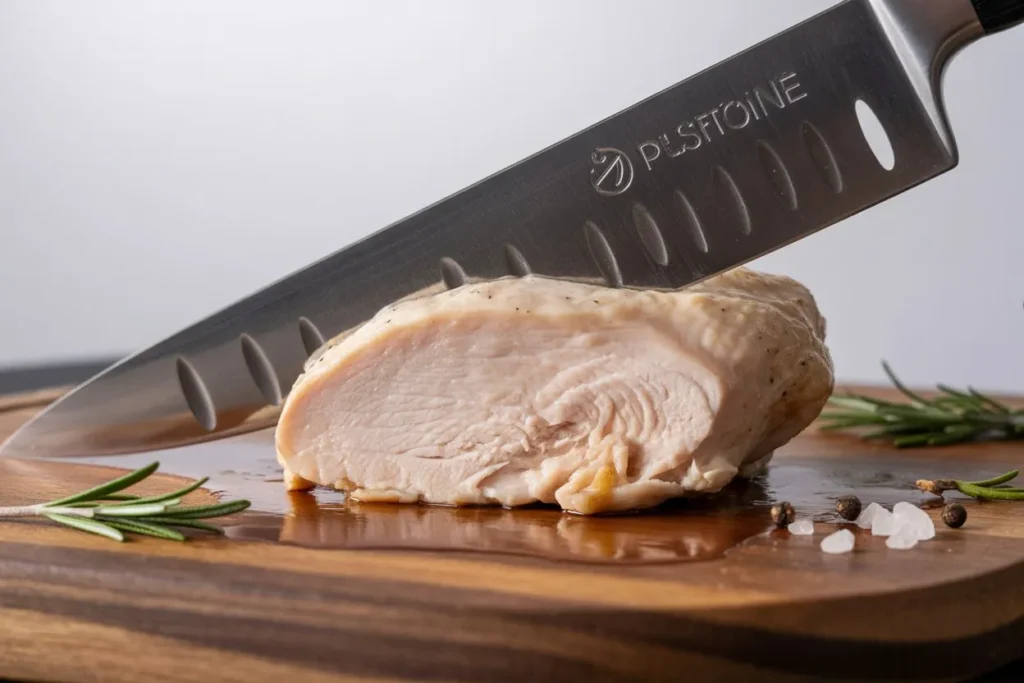
Frequently Asked Questions (FAQs)
Is it safe to sous vide straight from frozen?
Yes, absolutely. Cooking chicken breast sous vide directly from frozen is not only safe but recommended for convenience. Just make sure to add 30 minutes to the cooking time to allow for proper thawing and pasteurization in the water bath. Sous vide’s precise temperature control ensures complete pathogen kill when following FDA and USDA temperature guidelines.
How long can thawed chicken sit before cooking?
Once chicken has thawed (whether naturally or in a sous vide bath), you should cook it immediately unless it’s kept below 40°F. Sous vide cooking from frozen bypasses this concern entirely, making it a safer and more streamlined option.
Can I sous vide frozen chicken breasts that are still in store packaging?
No. Most store packaging is not sous vide safe and can leach harmful chemicals into the food. Always repackage chicken breasts into food-grade vacuum-seal or freezer-safe zip bags before freezing. Avoid using foam trays or bags with printed labels that can dissolve in heat.
What if the chicken breast is thick or uneven?
Uneven cuts can cook unevenly, but sous vide helps minimize this issue. If you’re working with a thick or irregular breast:
- Pound it slightly before freezing, or
- Increase cook time slightly (up to 2.5 hours total from frozen)
The sous vide process is forgiving, so even thicker breasts will become perfectly tender given enough time.
Can I sous vide frozen boneless skinless thighs the same way?
Yes! Boneless, skinless thighs can also be cooked from frozen using sous vide. They have a slightly higher fat content and remain juicy even at higher temps. Recommended settings:
- 165°F (74°C) for 1.5–2.5 hours from frozen
- 150°F (65.6°C) for ultra-tender texture
How do I reheat sous vide chicken without drying it out?
Reheat gently by:
- Returning the bagged chicken to a 130°F–140°F sous vide bath for 30–45 minutes
- Avoid using the microwave unless very low power is used in short bursts
- You can also slice and reheat in a covered skillet with a bit of broth or butter
Conclusion and Pro Tips for Best Results
Sous vide frozen chicken breast is the ultimate cooking hack simple, safe, and surprisingly gourmet. By skipping the thaw and cooking with precision, you avoid dry or rubbery meat and embrace convenience and flavor.
Top pro tips:
- Season before freezing for max flavor.
- Always cook in food-safe bags.
- Dry thoroughly before searing.
- Use a thermometer or visual cues to avoid over-searing.
- Keep a batch of pre-seasoned, vacuum-sealed chicken breasts in your freezer for anytime meals.
Whether you’re cooking for one or feeding a crowd, sous vide transforms frozen chicken into a flavorful, juicy, and restaurant-quality experience. Try different marinades, serve it over fresh veggies or grains, and never worry about forgetting to thaw again.
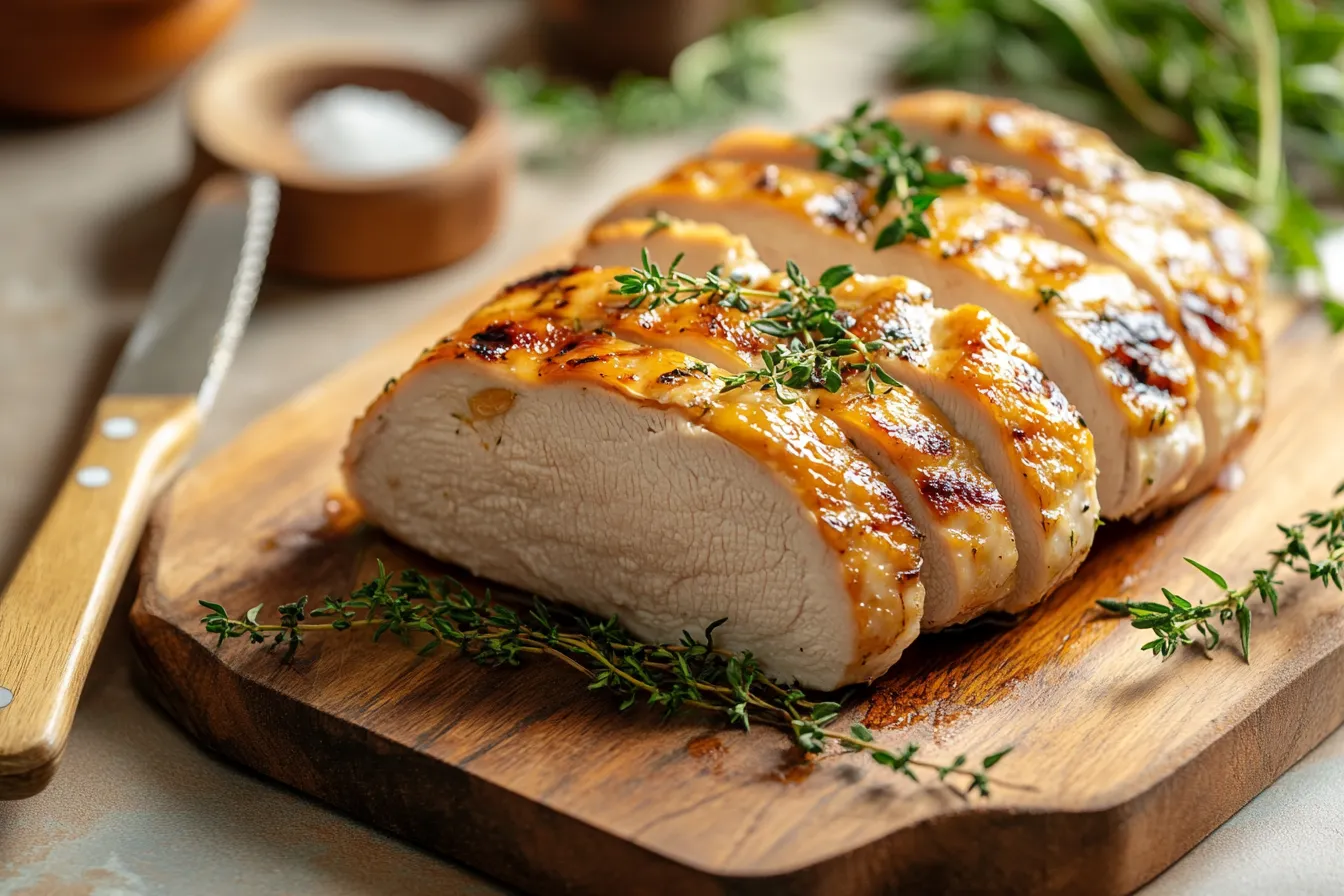
Name: Sous Vide Frozen Chicken Breast
Ingredients
Equipment
Method
- Instructions:
- Preheat the sous vide water bath to 140°F (60°C) for tender and juicy results (or up to 160°F for firmer texture).
- Season chicken breasts before freezing (or coat frozen chicken directly if using pre-seasoned packs).
- Place frozen chicken breasts into vacuum-sealed bags or zip bags using the water displacement method.
- Submerge bags fully in the preheated water bath. Cook for 1.5 to 2.25 hours, depending on thickness.
- Once done, remove chicken from bags and pat dry thoroughly with paper towels.
- Optional: Sear in a hot skillet with olive oil or butter for 30–60 seconds per side until golden brown.
- Rest briefly, slice across the grain, and serve.
